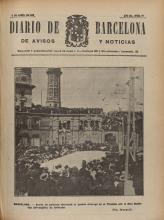The first issue of Companya. La Revista de la Dona came out on 11 March 1937. It was published on a fortnightly basis until January 1938, when it became weekly. A total of 18 issues were published until 8 March 1938. Produced in Barcelona, it was also distributed in other Catalan towns. The editorial team consisted of M. Lluïsa Algarra, M. Lluïsa Bargés, Aurora Bertrana, Lena Imbert, Eloïna R. Malasechevarría and Montserrat Martínez. The magazine was the mouthpiece of the Unió de Dones de Catalunya [Women’s Union of Catalonia or UDC], headed by M. Dolors Bargalló. At the time, the association had more than 30,000 members of various ideologies united by their anti-fascism, although the communists had the greatest influence over strategy. The UDC’s action was based on mobilising women in the rearguard.









